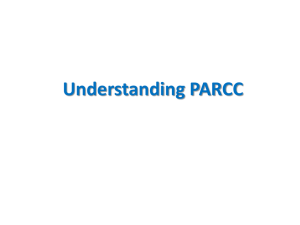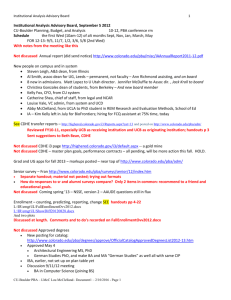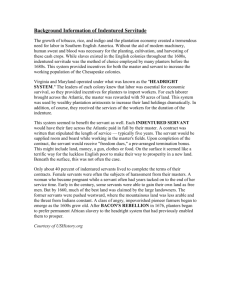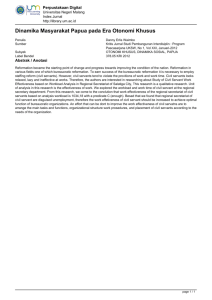A Pull-Based Approach for a VoD Service in P2P Networks
advertisement
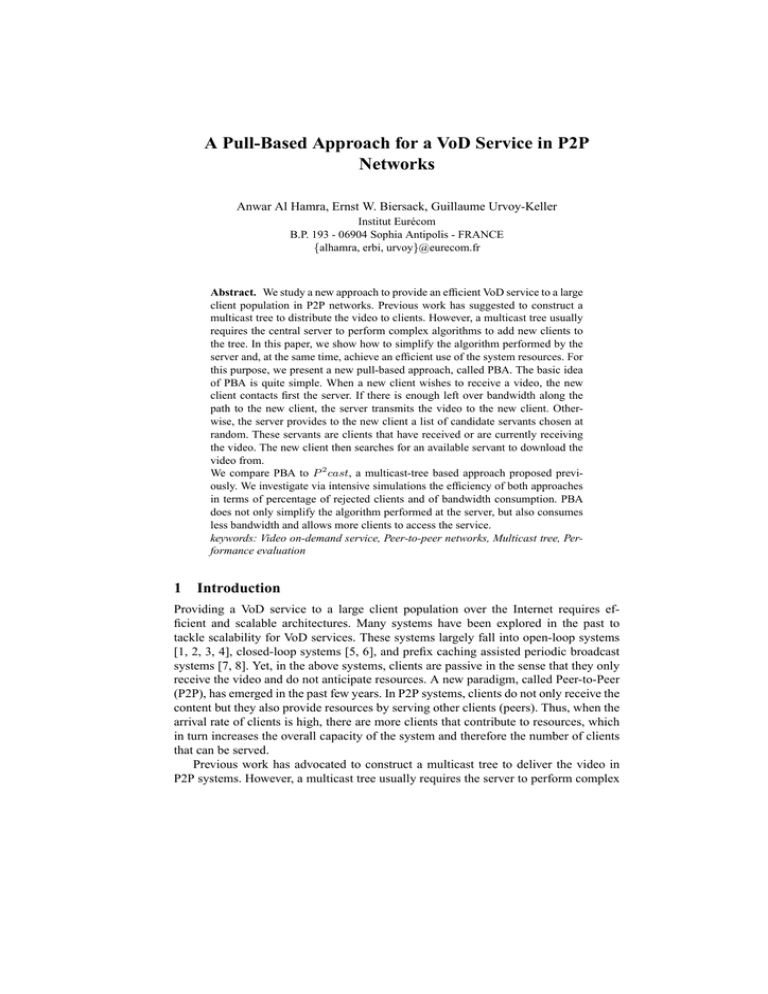
A Pull-Based Approach for a VoD Service in P2P
Networks
Anwar Al Hamra, Ernst W. Biersack, Guillaume Urvoy-Keller
Institut Eurécom
B.P. 193 - 06904 Sophia Antipolis - FRANCE
{alhamra, erbi, urvoy}@eurecom.fr
Abstract. We study a new approach to provide an efficient VoD service to a large
client population in P2P networks. Previous work has suggested to construct a
multicast tree to distribute the video to clients. However, a multicast tree usually
requires the central server to perform complex algorithms to add new clients to
the tree. In this paper, we show how to simplify the algorithm performed by the
server and, at the same time, achieve an efficient use of the system resources. For
this purpose, we present a new pull-based approach, called PBA. The basic idea
of PBA is quite simple. When a new client wishes to receive a video, the new
client contacts first the server. If there is enough left over bandwidth along the
path to the new client, the server transmits the video to the new client. Otherwise, the server provides to the new client a list of candidate servants chosen at
random. These servants are clients that have received or are currently receiving
the video. The new client then searches for an available servant to download the
video from.
We compare PBA to P 2 cast, a multicast-tree based approach proposed previously. We investigate via intensive simulations the efficiency of both approaches
in terms of percentage of rejected clients and of bandwidth consumption. PBA
does not only simplify the algorithm performed at the server, but also consumes
less bandwidth and allows more clients to access the service.
keywords: Video on-demand service, Peer-to-peer networks, Multicast tree, Performance evaluation
1 Introduction
Providing a VoD service to a large client population over the Internet requires efficient and scalable architectures. Many systems have been explored in the past to
tackle scalability for VoD services. These systems largely fall into open-loop systems
[1, 2, 3, 4], closed-loop systems [5, 6], and prefix caching assisted periodic broadcast
systems [7, 8]. Yet, in the above systems, clients are passive in the sense that they only
receive the video and do not anticipate resources. A new paradigm, called Peer-to-Peer
(P2P), has emerged in the past few years. In P2P systems, clients do not only receive the
content but they also provide resources by serving other clients (peers). Thus, when the
arrival rate of clients is high, there are more clients that contribute to resources, which
in turn increases the overall capacity of the system and therefore the number of clients
that can be served.
Previous work has advocated to construct a multicast tree to deliver the video in
P2P systems. However, a multicast tree usually requires the server to perform complex
algorithms to allow new arrivals to join the tree. In this paper, our goal is to show that
we can achieve both, a simple server algorithm and an efficient resources management.
For this purpose, we introduce a new pull-based approach, called PBA. The basic idea
of PBA is quite simple. When a new client wishes to receive a video, the new client
contacts first the server. If the server is not overloaded and there is enough left over
bandwidth along the path to that new client, the server feeds the new client with the
video. Otherwise, the server responds to the new client with a list of servants (peers)
chosen at random. These servants are clients that have received or currently receiving
the video. The new client then searches for an available servant from which it downloads
the video.
We compare PBA to P 2 cast [9], a multicast-tree based approach proposed previously. We investigate via intensive simulations the efficiency of PBA and P 2 cast. Our
conclusion is that PBA does not only simplify the server as compared to a multicast-tree
based approach, but it also consumes less bandwidth, which allows more clients to be
serviced. The rest of this paper is organized as follows. Section 2 presents related work.
Section 3 introduces PBA model. Section 4 presents the simulation settings. Section 5
provides results. Section 6 addresses service disruptions. Section 7 concludes the paper.
2 Related Work
Previous work on VoD can be largely classified into open-loop schemes, closed-loop
schemes, and prefix-assisted periodic broadcast schemes.
Concerning open-loop schemes, Staggered broadcasting [1] is the most straightforward one where the server allocates for each video C channels each with a bandwidth
equal to the playback rate b of the video. On each channel, the whole video is broadcast
at rate b. The starting points of the transmission on the different channels are shifted in
time to guarantee a start-up delay of no more than L/C, where L is the length of the
video.
More efficient and complicated schemes have been proposed later on [2, 3, 4]. The
key idea is that each video is divided into many segments. The server transmits each
segment periodically and infinitely each at its own rate. These schemes differ in the way
they set the rate and the size of each segment. For more details on open-loop schemes
see [10].
While open-loop schemes broadcast the video regardless of the clients request pattern, closed-loop schemes serve the video in response to clients requests. Hierarchical
merging [6] is the most efficient closed-loop scheme. As its name indicates, this scheme
merges clients in a hierarchical manner. When a new client arrives, the server initiates
an unicast stream to that client. At the same time, the client starts listening to the closest
(in time) stream (target) that is still active. When the client receives via unicast all what
it missed in the target stream, the unicast stream is terminated and the client listens only
to the target stream, and the process repeats.
On the other hand, prefix caching assisted periodic broadcast schemes [7, 8] combine open-loop and closed-loop systems. They divide the video into two parts, the prefix
and the suffix. The prefix is delivered via a closed-loop scheme while the suffix is multicast via an open-loop scheme. This combination makes these schemes suitable for both
popular and non-popular videos.
In P2P environments, most of the existing approaches relie on constructing and
maintaining a multicast tree rooted at the server [11, 12, 13, 14, 9]. P 2 cast [9] belongs to this family of approaches. It applies multicast controlled threshold [5] to P2P
systems. It divides each video into two parts, the patch and the suffix. The patch is delivered via unicast while the suffix is delivered through a multicast tree rooted at the
server. P 2 cast will be more detailed in section 4.
3 PBA: A Pull-Based Approach for a VoD Service
PBA’s main advantage is to keep the server as simple as possible. When a new client
wants to receive a video, it first contacts the server. In case there is enough available
bandwidth along the path between the server and the new client, the server unicasts
the video directly to the new client. In contrast, in case there is not enough available
bandwidth, the server responds to the new client with the IP addresses of Ns servants
chosen at random. The new client then tries to find an available servant to download the
video from it via unicast.
Actually, estimating the available bandwidth between two end hosts in the Internet
is not an easy task. Moreover, the available bandwidth of a connection might fluctuate
over time. In this paper we do not address these issues. Our goal here is to show that
as compared to a multicast tree-based approach, a pull-based approach simplifies the
server and saves bandwidth resources. In addition, assuming a static network allows us
to better understand the basic behavior of PBA (and P 2 cast later). Hence, we assume
that (i) Each connection has a transfer rate equal to the playback rate b of the video and
(ii) A connection is set up (and can not be interrupted) in case the left over bandwidth
along the path of that connection is larger than or equal to b.
3.1
The Server Task
When the server receives a request for a video from a new client, it estimates the available bandwidth along the path to that new client. In case the estimated available bandwidth is larger than or equal to the playback rate b of the video, the server unicasts the
video to the new client. Otherwise, the server responds to the new client with the IP
addresses of Ns servants. The server chooses at random Ns servants amongst active
clients (peers) in the network.
3.2
The New Client Task
A new client first sends a request to the server to retrieve a video. If the available bandwidth along the path between the server and the new client is less than b, the server
provides the new client with the IP addresses of Ns servants chosen at random. The servants are clients that have downloaded or are currently downloading the video. The new
client then tries to improve this initial list of servants by accounting for local servants,
i.e. servants that are located in its local area network. The motivation is that, retrieving
the video from local clients saves bandwidth in the core of the network, which allows
more clients to access the service. To discover local servants, the new client broadcasts
locally a message. Each client that receives this message responds to the new client indicating its arrival time. We denote by Nls the number of local servants found. If Nls is
larger than Ns , the new client replaces its initial list of servants by the Ns most recent
local servants. In contrast, if Nls is less than Ns , the new client replaces at random Nls
servants in its initial list by the Nls local ones. Afterwards, the new client searches for
an available servant to download the video. The new client contacts its servants starting
with the local ones. If none of them is available, it contacts at random one of the non
local ones. The new client keeps on contacting its servants until (i) A servant accepts to
serve it. In this case, the new client joins the network and sends a message to notify the
server. (ii) None of the candidate servants accepts to serve the new client. In this case,
the new client is rejected.
3.3
The Servant Task
When a servant receives a request for a video from a new client, the servant estimates
the available bandwidth to the new client. If the available bandwidth is larger than or
equal to b, the servant unicasts immediately the video to the new client. Otherwise, the
servant rejects the request.
In case the servant is behind a firewall, the servant can push the video towards the
new client. However, the client can not get the video in case both, the servant and the
new client are behind firewalls. To avoid such a scenario, we can require the server to
choose an appropriate list of servants for the new client. Also, one might think of having
intermediate proxies that allow two peers to communicate. This will be investigated
more in future work.
4 Performance Evaluation
Constructing a multicast tree to distribute the video to clients has been advocated in
previous work. Such approaches usually require the server to run complex algorithms
to construct the multicast tree and, most often, do not account for the physical distance
between the client and its servant. Our goal in this paper is to show that we can simplify
the algorithm performed at the server and, at the same time, use less system resources.
To this purpose, we will compare our pull-based approach PBA to P 2 cast, a multicasttree based approach.
4.1
Overview of P2 cast
P 2 cast [9] applies multicast controlled threshold [5] to P2P systems. The first client
that requests the video receives a complete stream for the whole video from the server.
A new client that arrives within a threshold Tcast after the first client connects to that
complete stream that changes from unicast to multicast. In addition, the new client receives immediately from the server a unicast patch for the part it missed in the complete
stream due to its late arrival. On the other hand, the next client that arrives later than
Tcast after the first client, it receives a new complete stream and new clients are patched
again within the same new complete stream instead of the old one until the threshold
time passes again and the same process is repeated.
Hence, P 2 cast divides each video into a patch and a suffix. The patch is delivered
via unicast while the suffix is delivered on a multicast tree rooted at the server 1 . When
a new client nc requests a video, nc contacts a client P starting from the server. P
estimates its bandwidth BW (P, nc) to nc. Meanwhile, P asks its child to estimate
their bandwidth to nc. The child that has the largest bandwidth BW (cmax, nc) to nc
amongst all child is denoted by cmax. In case of tie, the closest child is chosen. P
compares BW (P, nc) to BW (cmax, nc) and three scenarios are then possible:
– BW (P, nc) > BW (cmax, nc) and BW (P, nc) ≥ 2b. Then, nc receives the patch
directly from P and joins the multicast tree for the suffix as a child of P .
– BW (P, nc) > BW (cmax, nc) and 2b > BW (P, nc) ≥ b. In this case, P delivers the patch to nc and forwards the request for the suffix stream to the child
cmax. cmax then estimates its bandwidth to nc and asks its child to estimate their
bandwidth to nc and the same process is repeated.
– [BW (P, nc) > BW (cmax, nc) and BW (P, nc) < b] or [BW (P, nc) < BW (cmax, nc)].
Then, P forwards the request to cmax and the process above is repeated.
4.2
Simulation Settings
In this study, we consider the case of a single video of length L. However, the study
can be easily generalized to the multiple videos case. In P 2 cast, clients that share the
same multicast stream form a session. Sessions are completely independents and there
are no interactions between clients from different sessions. In contrast, PBA has no
such constraint and a new client can retrieve the video from any other client. However,
to make a fair comparison between PBA and P 2 cast, we should take into account the
session limitation of P 2 cast. Therefore, we introduce for PBA a threshold, Tpba , to limit
the interaction between clients. Suppose that client C1 has joined the network at time
t0 . C1 can download the video only from clients that arrived between time t0 − Tpba
and t0 .
In the following, we will assume that clients request the video from the beginning
to the end (no early departure) and that there are no service disruptions. In fact, service
disruptions represent a main challenge for P2P systems. in section 6, we discuss how to
extend PBA to deal with service disruptions. However, in the performance evaluation,
we do not concern with these issues. The reason is that we are interested in evaluating
the bandwidth consumption and the percentage of rejected clients for a multicast treebased approach and a pull-based approach. Hence, in this comparison, we assume that a
client leaves the system only if (i) It has completely received the video and (ii) It is not
a servant for any other client. Thereby, the maximum amount of time spent by a client
in the network is given by:
(
max(L, 2 · Tcast )
for P 2 cast
(1)
Ts =
L + Tpba
for P BA
1
As we will see later, a P 2 cast client helps delivering both, the patch and the suffix.
We choose the values of Tpba and Tcast in such a way that Ts is the same for both
approaches. In this comparison, we will consider the same environment as in the performance evaluation of P 2 cast in [9]. Thus, we consider the network of 100 nodes2
(figure 1). The network has been produced by GT-ITM [15]. It consists of two levels,
Fig. 1. A 100 nodes network topology
the transit-domain level and the stub-domain level. We assume that each stub-domain
node is an abstraction of a local area network. However, we limit the number of streams
inside each local network to Lbw . For instance, consider a local network A for a stubdomain node. At the same time, the maximum number of connections that have at least
one of its two ends located in A can not exceed Lbw . Each connection has a transfer rate
of b. We set the capacity of each link between two transit-domain nodes (BWtt ) or between a transit-domain node and a stub-domain node (BWts ) to BWtt = BWts = 20b.
This means that, at the same time, such a link can support up to 20 streams each of rate
b. For a link between two stub-domain nodes, we set its capacity to BWss = 5b.
We assume that clients arrive to the network according to a Poisson process with a
total aggregate rate λ. Clients connect only to stub-domain nodes, which all have the
same probability to receive a new client. We will consider the following scenario where:
(i) The network includes four transit-domain nodes (the four nodes in the middle) and
96 stub-domain nodes. (ii) The server is placed in the transit domain, i.e. the shaded
square in the middle (Sp = transit-domain). (iii) We set Tpba to 10 min for PBA. From
equation (1) we obtain Ts = L + Tpba = 110 min. Given that value of Ts , the value
of Tcast for P 2 cast is Tcast = 55 min3 . (iv) The maximum number of servants a client
2
3
In this paper, a node refers only to a router and a peer refers only to a client.
We outline that this larger value of Tcast gives more advantages to P 2 cast as compared to
PBA.
can contact is Ns = 10. (v) The bandwidth capacity of each local area network is
Lbw = 50b.
In both approaches, PBA and P 2 cast, we account for the output capacity Cout of
clients. We consider two values of Cout = {2, 10}. The value Cout = 2 (respectively
10) means that an existing client can deliver at most two (respectively 10) streams at
the same time each at rate b. In the performance evaluation, we are interested in (i)
The percentage of rejected clients. (ii) The average number of hops the data traverse in
the network. The term hop accounts for a link between any two nodes in the network.
(iii) The system cost expressed in units of b. The system cost is computed as the sum
of the amount of bandwidth expended over all links in the network during an interval
of time of length L. We evaluate these metrics for a wide range of clients arrival rate
λ (clients/min). We define the system workload W as the average number of arriving
clients per L (W = λL).
5 Simulation Results
In the following, we present results for the case of a single video of length L = 100
min. We run the simulation for a time of 1000 min = 10 · L, where the first 100 min are
to warm up the system.
In figure 2(a), we plot the percentage of rejected clients for PBA and P 2 cast vs
the system workload W. Figure 2(a) shows that, as compared to P 2 cast, PBA reduces
significantly the percentage of rejected clients when the system workload W is high.
such a reduction can reach 80%. Under a low workload (W = 10), the two approaches
perform well and almost no clients are rejected. For P 2 cast, as W increases, the percentage of rejected clients increases monotonically. In addition, to achieve a reasonable
performance, P 2 cast requires clients to have a large output capacity (i.e. Cout = 10).
On the other hand, for PBA, the percentage of rejected clients does not increase monotonically with W . This is due to the threshold Tpba that we have introduced. Tpba limits
the number of candidate servants for new clients. For instance, for W = 100 (i.e. 100
arriving clients per L), on average, 10 clients arrive within an interval of time T pba = 10
min. Thus, few clients can collaborate with each other and candidate servants will be
probably located far from the new client. Therefore, clients need to go far in the network to reach their servants. As a result, more bandwidth is consumed in the core of
the network, which leads to congestion and clients rejection. When W exceeds 1000,
the probability of finding a local servant increases and more clients are served locally.
This saves bandwidth in the core of the network and allows to serve more clients. Consequently, the percentage of rejected clients starts decreasing for PBA. For W > 5000,
the performance of both, PBA and P 2 cast deteriorates. This is mainly due to limiting
the number of streams in a local network (Lbw = 50 streams per local network).
Figure 2(b) supports our intuition. Figure 2(b) depicts the average distance (in terms
of hops) between clients and their servants. Recall that, the term “hop” accounts for a
link between any two nodes (routers). Thereby, we do not account for the distance
traveled by the data inside the local networks. So, the value zero for the number of
hops between a servant and a client means that both, the servant and the client are
located in the same local network. As we can observe from figure 2(b), as W increases,
L=100, Nodes=100, Lbw=50, Sp=transit−domain, Tpba=10, Tcast=55, Ns=10
90
80
L=100, Nodes=100, Lbw=50, Sp=transit−domain, Tpba=10, Tcast=55, Ns=10
4
PBA, C =2
out
PBA, Cout=10
2
P Cast, C =2
out
P2Cast, Cout=10
PBA, C =2
out
PBA, C =10
out
2
P Cast−patch, C =2
out
P2Cast−patch, C =10
out
2
P Cast−suffix, C =2
out
2
P Cast−suffix, Cout=10
3.5
3
average number of hops
percentage of rejected clients
70
60
P2Cast
50
40
PBA
30
2.5
2
1.5
P2Cast, Cout=2
P2Cast, Cout=10
1
PBA
20
0.5
10
0
1
10
2
3
10
10
4
10
system workload W
(a) percentage of rejected clients
0
1
10
2
3
10
10
4
10
system workload W
(b) average number of hops
Fig. 2. The percentage of rejected clients and the average number of hops as a function
of the system workload W , for a network of 100 nodes, Lbw = 50, the server is placed in
the transit-domain, the number of servants is Ns = 10, Tpba = 10 min, and Tcast = 55
min.
the average number of hops decreases. For W > 1000, the average number of hops
becomes smaller than 1, which means that the majority of clients are served by local
servants.
So far, we have seen how, at a high system load, PBA allows more clients to access
the service as compared to P 2 cast. Let us now consider the total system cost for the
two approaches. The system cost is computed as the sum of bandwidth consumed over
all links in the network during an interval of time of length L. In figure 5 we draw the
system cost for both approaches as a function of the effective system workload W e .
We represents the number of admitted clients who get access to the service. We denote
P BA
P 2 cast
by Ccost
and Ccost
the system costs of PBA and P 2 cast respectively. As we can
observe from figure 5, PBA consumes less bandwidth than P 2 cast for large values of
We . For moderate values of We (i.e. We = 100), P 2 cast slightly outperforms PBA.
As mentioned above, this is mainly due to the threshold Tpba that we introduced for
P BA
PBA to limit the interaction between clients. When We reaches 1000, Ccost
decreases,
which means that new clients always find local servants to download the video and less
P BA
bandwidth is consumed in the core of the network. If we look at Ccost
for We > 5000,
we can notice that it increases again. The reason is that, limiting the bandwidth capacity
of local networks to Lbw = 50 streams forces clients to connect to servants further away.
Note that we also investigated the efficiency of both approaches for other scenarios.
The results that we obtained are similar to what we have showed.
5.1
Impact of the choice of Servants
In the initial version of PBA, the server chooses the Ns servants at random amongst
active clients. In this section, we evaluate an improved version of PBA in case the server
is able to account for the physical distance between servants and clients. This means
L=100,
Nodes=100, Lbw=50, Sp=transit−domain, Tpba=10, Tcast=55, Ns=10
5
8
x 10
PBA, Cout=2
2
P Cast, Cout=2
PBA, Cout=10
P2Cast, C =10
7
out
6
system cost
5
4
PBA
3
2
1
2
P Cast
0
0
10
1
2
10
3
10
4
10
10
effective system workload W
e
Fig. 3. The system cost for PBA and P 2 cast, for a network of 100 nodes, Lbw = 50, the
server is placed in the transit-domain, the number of servants is Ns = 10, Tpba = 10
min, and Tcast = 55 min.
that, instead of choosing Ns servants at random, the server chooses the Ns closest ones
to the new client. We refer to this approach as CSF (Closest Servant First). In case of
tie, the most recent one is chosen first. Finding nearby clients in the Internet has been
addressed recently and an interesting work has been done for this purpose [16, 17].
We compare PBA to CSF to figure out the gain that can be achieved if (exact)
locality information are available. The implementation issues are not treated here. In
figure 4(a) we draw the percentage of rejected clients for both approaches vs the system
workload W . As we can observe from figure 4(a), CSF outperforms significantly PBA
L=100, Nodes=100, Lbw=50, Sp=transit−domain, Tpba=10, Ns=10
5
7
60
x 10
6
L=100, Nodes=100, Lbw=50, Sp=transit−domain, Tpba=10, Ns=10
CSF, Cout=2
CSF, Cout=10
PBA, Cout=2
PBA, Cout=10
PBA
5
40
system cost
percentage of rejected clients
50
CSF, C =2
out
CSF, Cout=10
PBA, Cout=2
PBA, Cout=10
PBA
30
4
CSF
3
20
2
CSF
10
0
1
10
2
1
3
10
10
system workload W
(a) percentage of rejected clients
4
10
0
0
10
1
10
2
10
3
10
4
10
effective system workload We
(b) system cost
Fig. 4. The percentage of rejected clients and system cost for both, PBA and CSF, for a
network of 100 nodes, Lbw = 50, the server is placed in the transit-domain, the number
of servants is Ns = 10, Tpba = 10 min, Tcast = 55 min, and W = 5000.
for large values of W (i.e. W = 1000). Indeed, in CSF, a new client always contacts
a near by servant. In contrast, in PBA, if the new client finds no local servant, it picks
one candidate at random. For W = 1000 arrivals per the video length L, there are
100 arriving clients within a Tpba of 10 min. These 100 clients will be distributed over
96 stub-domain nodes. This gives on average 1 client per stub-domain node. Thus, a
new client finds with a large probability a near by servant but not a local one. This
explains why CSF outperforms PBA for W = 1000. In contrast, for W = 100, this
locality property has no main impact as candidate servants are few (i.e. ' 10 servants
distributed over 96 nodes) and most probably located far away from the new client.
Hence, choosing the closest servant or one at random gives the same result. When W
becomes high (W > 1000), the probability of having a local servant increases and
the performance of PBA improves. For high values of W (W ≥ 3000), a new client
finds always a local servant and as a consequence, both PBA and CSF have the same
performance. For W ≥ 5000, the performance of both approaches deteriorates due to
limiting the bandwidth capacity of local area networks to Lbw = 50 streams.
Figure 4(b) depicts the system cost for each of the two approaches as a function of
the effective system workload We . Figure 4(b) confirms our intuition, i.e. accounting
for the physical distance between servants and clients allows to save bandwidth and
reduces the system cost.
6 Service Disruptions
A main challenge for P2P systems is how to deal with service disruptions. When a client
leaves the network, all its descendents will stop receiving the stream until they find a
new servant. Also the network state changes dynamically and the available bandwidth
between two end hosts might fluctuate over time. This has for sure a severe impact
on the service the system offers to its clients. PBA can be extended to handle these
issues. The key idea is to allow clients to contact multiple servants instead of a single
one. Clients perform locally a greedy algorithm to download different portions of the
video from multiple servants at the same time. We assume that the video consists of a
sequence of ordered portions. When a new client arrives to the network, it first contacts
the server. The server answers to the new client with the IP addresses of Ns candidate
servants. The client then connects to Ncs out of its Ns servants. Each time a portion that
has been requested from a servant is completely downloaded, the client requests from
that servant the next portion that has not yet been requested from any other servant. We
can pipeline requests to avoid idle times in the different connections.
When a client receives no packet from one of its servants during a given interval
of time, the client considers that the servant has left the network. It then drops the
connection to that servant and sets up a new connection with a new servant from its list.
Many of recent approaches such as BitTorrent [18] advise the use of parallel download to retrieve the content. Indeed, parallel download helps distributing the charge over
the network. In addition, having multiple servants with a total aggregate download rate
larger than b (the playback rate of the video) allows clients to quickly fill their buffer.
Thereby, when a servant leaves the network, its children should have enough data in
their buffer to find a new servant and consequently, experience no interruptions while
playing out the video. Parallel download also makes clients less sensitives to the bandwidth fluctuation in the network since the parallel download algorithms always post
more requests to the servants that offer the best response time and thus smooth out
the load. We leave the quantitative evaluation of this parallel download approach (e.g.
choice of Ncs , ...) as future work.
7 Conclusion
Previous work on VoD in P2P networks has suggested to construct multicast trees to
deliver the video to clients. However, such approaches usually make the server complex.
In this paper our goal was to show that we can simplify the algorithm performed at
the server and, at the same time, save system resources. For this purpose, we have
introduced a new pull-based approach, called PBA. PBA keeps the server as simple as
possible. When a new client wishes to receive a video, the new client first contacts the
server. If there is enough left over bandwidth along the path to the new client, the server
unicasts the video to the new client. Otherwise, the server responds to the new client
with a list of candidate servants. These servants are clients that have received or are
currently receiving the video. The new client searches then for an available servant to
download the video from.
We compared PBA to P 2 cast, a multicast-tree based approach proposed previously.
Our results showed that PBA consumes significantly less bandwidth and allows more
clients to access the service. We then investigated the impact of the choice of servants on
the performance of PBA. We showed that allowing the server to choose the Ns closest
servants to the new client reduces the bandwidth consumed in the core of the network
and allows to serve more clients.
We also discussed how to extend PBA to deal with service disruptions and dynamic
changes in the network conditions. The key idea is that, instead of contacting a single
servant, a PBA client can perform a parallel download of the video. This makes clients
less sensitives to bandwidth variations in the network as well as unexpected departures
of servants.
8 Acknowledgments
The authors would like to thank Marry Vernon for her helpful discussions and comments.
References
[1] Almeroth, K.C., Ammar, M.H.: On the use of multicast delivery to provide a scalable and
interactive video-on-demand service. In: IEEE JSAC. Volume 14. (1996) 1110–1122
[2] Viswanathan, S., Imielinski, T.: Pyramid broadcasting for video on demand service. In:
Proc. of Multimedia Conference, San Jose, CA (1995)
[3] Birk, Y., Mondri, R.: Tailored transmissions for efficient near-video-on-demand service.
In: Proc. of ICMCS. (1999) 226–231
[4] You, P.F., Pâris, J.F.: A better dynamic broadcasting protocol for video on demand. In:
Proc. of IPCCC, Phoenix, AZ (2001) 84–89
[5] Gao, L., Towsley, D.: Supplying instantaneous video-on-demand services using controlled
multicast. In: Proc. of IEEE Multimedia Computing Systems. (1999) 117–121
[6] Eager, D., Vernon, M., Zahorjan, J.: Optimal and efficient merging schedules for video-ondemand servers. In: Proc. of ACM Multimedia. (1999)
[7] Guo, Y., Sen, S., Towsley, D.: Prefix caching assisted periodic broadcast: Framework and
techniques for streaming popular video. In: Proc. of IEEE ICC. (2002)
[8] Biersack, E.W., Hamra, A.A., Urvoy-Keller, G., Choi, D.: Cost-optimal dimensionig of a
large scale video on demand server. In: Quality of Future Internet Services COST Action
263 Final Report. Volume 2856 of Lecture Notes in Computer Science., Springer-Verlag
(2003)
[9] Guo, Y., Suh, K., Kurose, J., Towsley, D.: P2cast: Peer-to-peer patching scheme for vod
service. In: Proc. of the 12th World Wide Web Conference (WWW), Budapest, Hungary
(2003)
[10] Hu, A.: Video-on-Demand broadcasting protocols: A comprehensive study. In: Proc. of
Infocom. Volume 1., Anchorage, Alaska, USA (2001) 508–517
[11] Deshpande, H., Bawa, M., Garcia-Molina, H.: Streaming live media over a peer-to-peer
network. CSD, Stanford University (2001)
[12] Xu, D., Hefeeda, M., Hambrusch, S., Bhargava, B.: On peer-to-peer media streaming. In:
Proc. of 22nd International Conference on Distributed Computing Systems, Washington Brussels - Tokyo (2002) 363–371
[13] Padmanabhan, V.N., Wang, H.J., Chou, P.A., Sripanidkulchai, K.: Distributing streaming
media content using cooperative networking. In: Proc. of ACM/IEEE NOSSDAV. (2002)
[14] Tran, D.A., Hua, K.A., Do, T.T.: A peer-to-peer architecture for media streaming. To
appear in IEEE JSAC Special Issue on Advances in Overlay Networks (2003)
[15] Zegura, E.W., Calvert, K., S.Bhattacharjee: How to model an internetwork. In: Proc. of
Infocom. (1996) 594–602
[16] ylvia Ratnasamy: A Scalable Content-Addressable Network. PhD thesis, University of
California (2002)
[17] Krisnamurthy, B., Wang, J.: On network-aware clustering of web sites. In: Proc. of SIGCOMM. (2000)
[18] Cohen, B.:
Incentives to build robustness in bittorrent.
Technical report,
http://bitconjurer.org/BitTorrent/bittorrentecon.pdf (2003)


